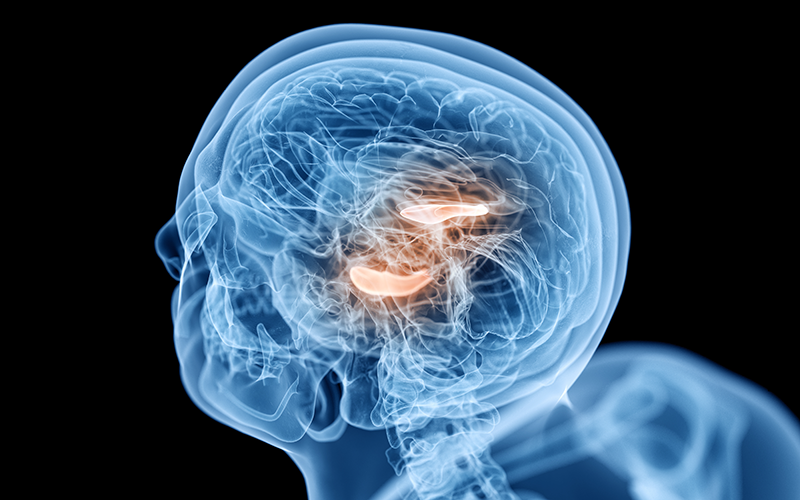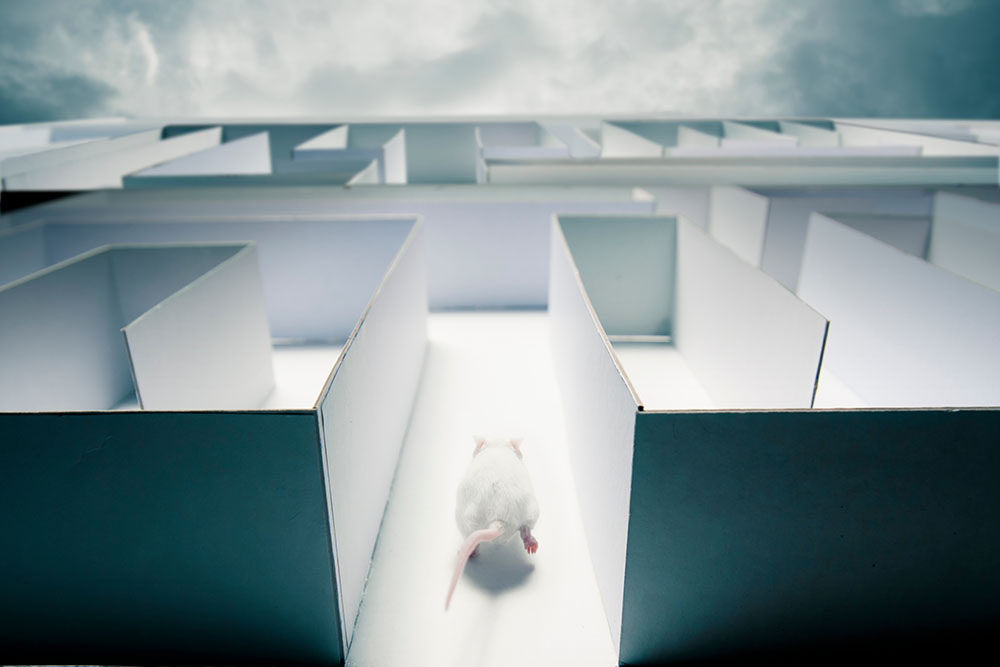New Neurons Push Away PTSD
IRP Researchers Explore How the Brain Shrugs Off Severe Stress

IRP studies on rats suggest that the ability to recover from traumatic experiences may be linked to a particular brain area’s capacity to generate new neurons.
Deep within the brain, a structure called the hippocampus serves as a hub where memory and emotion collide, helping us to learn what not to do if we want to stay safe. However, for the 12 million people in the U.S. with post-traumatic stress disorder (PTSD), those self-preservation instincts kick into overdrive, with severe consequences for quality of life.
June is PTSD Awareness Month, which draws attention to an often-debilitating condition that occurs when people who have experienced or witnessed a traumatic event or period in their lives continue to experience severe depression and anxiety for months or years afterward. While there are a variety of medications and therapies that can help people with PTSD, not everyone benefits from those treatments. Before scientists can develop additional treatment options, they must learn more about the biological roots of the condition, so IRP senior investigator Heather Cameron, Ph.D., is doing her part by examining how stress affects the hippocampus, one of the few brain regions where new neurons are continuously born.
“In most parts of the brain, the neurons you are born with are the only ones you’ll ever have,” says Dr. Cameron. “We know that neurogenesis, or neuron growth, in the adult hippocampus is inhibited by stress, so we are trying to understand what happens to behavior when new neuron growth is blocked.”
Magnetic resonance imaging (MRI) brain scans have shown that the hippocampus actually shrinks in people with major depression, PTSD, and other stress-related disorders, and gets bigger again when the condition is treated. What’s more, studies of rats show that chronic stress also shrinks neurons’ dendrites, the long branches that those brain cells use to receive messages from one another.

Dr. Cameron’s research focuses on a brain structure called the hippocampus, highlighted here.
After beginning to explore hippocampal changes in rats undergoing chronic stress, two questions stoked the curiosity of Dr. Cameron’s research team. First, the group wanted to better understand the role of new neurons in the growth and shrinkage of the hippocampus. Second, they wanted to know if brief episodes of stress — the kind that can sometimes trigger PTSD — had a similar effect on the hippocampus as long-term stress. To answer these questions, they essentially repeated some of the experiments they had performed previously, but condensed them into one horrible, no good, very bad day.
“If something bad happens over and over for weeks, it seems reasonable that you would actually see some sort of damage in the brain,” Dr. Cameron says, “but we really didn’t know what to expect as far as brief stress events go. We knew it could affect behavior but had no idea if it could change what the brain looks like.”
In Dr. Cameron’s study — led by Tim Schoenfeld, Ph.D., a former postdoctoral fellow in her lab who is now an assistant professor at Belmont University — normal rats and those bred to lack neurogenesis once they reached adulthood were exposed to a series of physically stressful experiences, such as swimming in cold water and being restrained in a clear tube. After experiencing all those various stressors one after another, the animals were returned to their cages to recover and get back to their usual routine. Initially, both types of rats behaved similarly after their stressful day, displaying signs of anxiety and caution toward new objects or foods placed in their surroundings.1

Dr. Heather Cameron
It wasn’t until over a month had passed that differences between the two types of rats became apparent. Intriguingly, by this point, the normal rats were behaving normally, but those without neurogenesis continued to behave anxiously, and this difference was reflected by structural changes in the hippocampus. In the rats whose brains could generate new neurons, the hippocampus had returned to normal size, but it remained smaller in those that could not create new neurons and continued to display signs of anxiety.
“The new neurons are required to push the animal back towards recovery,” Dr. Cameron explains.
Dr. Cameron and her team didn’t really expect to see such a clear outcome. After all, the stressful period for each rat lasted only two and a half hours, but their brains were still reeling from it in the months that followed.
“It felt like we might be headed into a six-month boondoggle,” Dr. Cameron says. “It seemed like there was a very high chance we wouldn’t see anything based on this short manipulation, but then when we did, the results were really exciting.”
In another intriguing development from the study, the IRP scientists found that the brain shrinkage caused by the single, highly stressful day was confined to a part of the hippocampus called ventral CA1, whereas chronic stress experienced over a series of days affected the entire hippocampus. That discovery fit with past research linking ventral CA1 to anxiety, including experiments showing that certain cells in that part of the hippocampus are active when mice are anxious.
Following those experiments, Dr. Cameron’s team decided to look at the same structural changes from the opposite perspective to determine what happens to the hippocampus after a positive experience. In that study, Dr. Cameron’s team tested rats’ behavior and looked at brain structure after the rats were rewarded for navigating one of two different types of mazes. One type of maze took rats on a single, winding route to a tasty reward, while the other required rats to make decisions and learn which way to travel to reach the same reward. The results were surprising.
“We found that the same region in the hippocampus, ventral CA1, increased in size when rats learned three different mazes over three weeks,” says Dr. Cameron. “Even though all of the rats got food rewards, the ones that had to make choices and learn how to find the food showed these structural and behavioral changes compared to the others.”

Rats and mice not only enjoy learning to navigate mazes, but it also has a noticeable effect on the structure of their brains.
Now, Dr. Cameron would like to carry these experiments forward to see how positive experiences might influence the effects of negative ones. Specifically, she wonders whether having positive experiences will protect rats from stressors they experience later or help them recover from stressful events that occurred in the past.
Of course, this research is in its early stages and examines brain and behavioral changes in rats, not humans, so applying the results to diagnosing or treating people remains a way off. Still, the discovery that the capacity to grow new neurons influences responses to severe stress poses tantalizing possibilities for helping people with PTSD and other psychiatric conditions.
“I've studied adult neurogenesis my entire career and it still captivates me as much as ever,” Dr. Cameron reflects. “We’ve learned so much about these new neurons over the years, but exactly what they do and how they do it is still a mystery. I've been so lucky to be able to study these questions for so long.”
Subscribe to our weekly newsletter to stay up-to-date on the latest breakthroughs in the NIH Intramural Research Program.
References:
[1] Schoenfeld TJ, Rhee D, Martin L, Smith JA, Sonti AN, Padmanaban V, Cameron HA. New neurons restore structural and behavioral abnormalities in a rat model of PTSD. Hippocampus. 2019 Sep;29(9):848-861. doi: 10.1002/hipo.23087.
Related Blog Posts
This page was last updated on Monday, June 26, 2023
